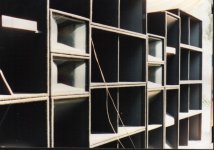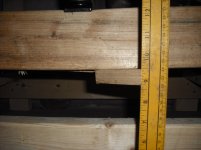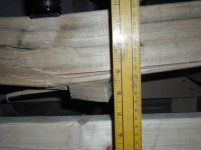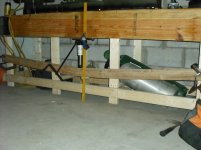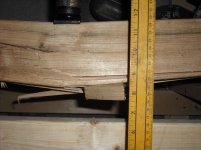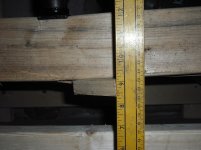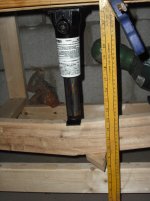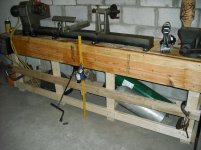Cal, you may know how to build a building properly, but neither you or I have any idea how this old and decrepit house was built or if it was damaged by termites.
Keep in mind, the air modulator had the displacement of a piston that was 8 by 12 feet moving a foot and a half peak to peak and if I recall had a net flow of about 30 cubic meters per second at “DC” and required it’s own 50KW 3 phase power drop to run it..
Also, to be perfectly clear, the entire middle of the wall was moving 8-10 inches including the window in the center but it takes more than 132 dB / 2lb per sqr foot to break a glass window.
It was possible to cause a roof fascia board to fall off as well as making a loud scary crunch under the house but I didn’t check to see what that was.
We did supply a different sonic boom simulator to a research company in California called BBN, it could push doors and windows out of their frames but was a sealed bunker type system and could produce 160dB at 5Hz.
Best,
Tom
the business end of it;
Keep in mind, the air modulator had the displacement of a piston that was 8 by 12 feet moving a foot and a half peak to peak and if I recall had a net flow of about 30 cubic meters per second at “DC” and required it’s own 50KW 3 phase power drop to run it..
Also, to be perfectly clear, the entire middle of the wall was moving 8-10 inches including the window in the center but it takes more than 132 dB / 2lb per sqr foot to break a glass window.
It was possible to cause a roof fascia board to fall off as well as making a loud scary crunch under the house but I didn’t check to see what that was.
We did supply a different sonic boom simulator to a research company in California called BBN, it could push doors and windows out of their frames but was a sealed bunker type system and could produce 160dB at 5Hz.
Best,
Tom
the business end of it;
Attachments
OK, if we're not taking this off line then:
No failure to grasp that at all my friend. My statement was made to convey the idea that if the wall did not move as a whole you would suffer structural failure. Perhaps I should have been more clear in that. The only way it would survive is if the wall moved as a whole. Even the flexiest (is that a word?) studs such as spruce will fail long before they flex 8 inches on edge. And, not sure of your knowledge of standard North American stick framing, but the fasteners used to secure the stud to the plates, even when back nailed, would give way long before the stud failed. This would move the whole wall as the fastening in the corner is not any greater than the fastening to the plates.
As evidenced by your failure to grasp the simple analogy that a building is a box whose corners aren't as flexible as the walls in the middle, rendering false your statement that a whole wall moves together.
No failure to grasp that at all my friend. My statement was made to convey the idea that if the wall did not move as a whole you would suffer structural failure. Perhaps I should have been more clear in that. The only way it would survive is if the wall moved as a whole. Even the flexiest (is that a word?) studs such as spruce will fail long before they flex 8 inches on edge. And, not sure of your knowledge of standard North American stick framing, but the fasteners used to secure the stud to the plates, even when back nailed, would give way long before the stud failed. This would move the whole wall as the fastening in the corner is not any greater than the fastening to the plates.
or if it was damaged by termites.
That would lead to premature failure, not extra flexiness.
Keep in mind, the air modulator had the displacement of a piston that was 8 by 12 feet moving a foot and a half peak to peak and if I recall had a net flow of about 30 cubic meters per second at “DC” and required it’s own 50KW 3 phase power drop to run it..
Tom, I don't question for a minute the air modulator's ability to do the job. You probably understood these things when you were a teenager more than I ever will, no doubt and no questions. I on the other hand have spent my working life in the construction industry from peon to chief bottle washer and have learned a thing or two along the way.
Ouch! Hopefully all you did was shift some floor joists or maybe put a small crack in the foundation. Those are possible without the place coming down.a loud scary crunch under the house
Tom, and the rest, as I tried to point out in my initial post is that instead of calling ********, I said there was some exaggerating done. I don't need to drive this home anymore. I'll stop when you guys do.
Cal, your statements are self conflicting - first you acknowledge that flexure does occur, but then that a wall must move as a whole, which conflicts with basic engineering principles available for your perusal in any basic engineering textbook.
You seem to be stuck on the magnitude, which is highly dependent on the wall dimensions.
If the height and width were doubled, the flexure in the middle before failure increases 8X.
You seem to be stuck on the magnitude, which is highly dependent on the wall dimensions.
If the height and width were doubled, the flexure in the middle before failure increases 8X.
Cal, again, keep in mind, this was an OLD junky house built on pillars (no foundation) that was vacated when they built the airbase years before (this was next to a runway). The wood trim etc that fell off was clearly rotted and the floors were very “springy”.
While you’ll never believe it’s possible and i understand that, I’ll never forget the sight of it happening, it was astonishing .
Best,
Tom
While you’ll never believe it’s possible and i understand that, I’ll never forget the sight of it happening, it was astonishing .
Best,
Tom
Tom,
I know what you mean. I've seen houses in so-cal shake during earthquakes in a way that made me think ' Yea... that's gonna collapse'. Then, once the wave front passed, they were still standing, seriously messed up, but still standing.
I know what you mean. I've seen houses in so-cal shake during earthquakes in a way that made me think ' Yea... that's gonna collapse'. Then, once the wave front passed, they were still standing, seriously messed up, but still standing.
Tom I am curious do you hold patents on this type of acoustic fan? (As opposed to Phoenix Gold cyclone, or trw-17) Could it be made to respond well enough to react to musical type signals? Why not a much smaller 30db scaled down home model?😀
No sir. No conflict at all.Cal, your statements are self conflicting
Without a doubtfirst you acknowledge that flexure does occur,
No. Please have the decency for all who are still following this to reread what I wrote. For the 3rd time, what I said and hopefully clearly this time is that the wall cannot move 8-10 inches by just flexing. If it is going to move 8-10 inches, it has to move as a whole or there will be failure of the structural members.but then that a wall must move as a whole
I am absolutely stuck on the magnitude. As far as dimensions are concerned, I am assuming a standard 8 foot house wall with 91.5" studs. If it is a little higher than that let's say a 10 foot wall it makes very little difference. The ability of the wall to flex that much without structural failure is out of the question. If the wall were displaced ie: either the fasteners at the corner blow out and the wall moves as a whole or the wall is so long it allows only the studs near the center of the wall to flex, it would still blow the fasteners of the studs off the plates with the center of the wall flexing outward. If that's the case the studs would never return to the original position and the wall, it's finish and the ceiling would either be on the floor or very close to it.You seem to be stuck on the magnitude, which is highly dependent on the wall dimensions.
As far as windows, well now we are talking an outside wall. There's not a lot holding them in so it doesn't matter if the window breaks or not, it's now out in the yard somewhere.
Hmm.... now where are we gonna find a two story stud so we can test this? Please stick to the subject. At one point I saw a glimmer of reasoning. Now I'm not sure what to think.If the height and width were doubled, the flexure in the middle before failure increases 8X.
EDIT: noah, I am wondering if I should have said the vertical members cannot flex that far without fracturing instead of calling it structural damage.
I’ll never forget the sight of it happening, it was astonishing .
Best,
Tom
I'll bet it was and I don't wish to take anything away from that memory.
Cheers.
No. Please have the decency for all who are still following this to reread what I wrote. For the 3rd time, what I said and hopefully clearly this time is that the wall cannot move 8-10 inches by just flexing. If it is going to move 8-10 inches, it has to move as a whole or there will be failure of the structural members.
I am absolutely stuck on the magnitude. As far as dimensions are concerned, I am assuming a standard 8 foot house wall with 91.5" studs. If it is a little higher than that let's say a 10 foot wall it makes very little difference. The ability of the wall to flex that much without structural failure is out of the question. If the wall were displaced ie: either the fasteners at the corner blow out and the wall moves as a whole or the wall is so long it allows only the studs near the center of the wall to flex, it would still blow the fasteners of the studs off the plates with the center of the wall flexing outward. If that's the case the studs would never return to the original position and the wall, it's finish and the ceiling would either be on the floor or very close to it.
EDIT: noah, I am wondering if I should have said the vertical members cannot flex that far without fracturing instead of calling it structural damage.
Eight inch peak to peak movement is a four inch bow in the center. I'd tend to agree that is probably past what a 3.5" stud can withstand.
However, a little web searching brings up that in the past lots of (cheap) houses were built with 2x4 put the thin way, 1.5” outside to inside.
I know from personal experience using an eight foot 2x4 (the thin way) as a pry bar that they will bow more than 4 inches before they break.
Let me rephrase that, some will break after about a 6” bow, others (with knots in the middle) snap quite easily.
I tend to learn by mistake 😱...
Art
Eight inch peak to peak movement is a four inch bow in the center. I'd tend to agree that is probably past what a 3.5" stud can withstand.
Hi Art, bowing, flexing and deflecting are one way measurements.
Interesting, I've not seen that unless it was done to cover something like the foundation in the basement, so not really a wall.However, a little web searching brings up that in the past lots of (cheap) houses were built with 2x4 put the thin way, 1.5” outside to inside.
Yes we used them on the flat to straighten walls during framing and a 12 footer will flex about a foot in the center.I know from personal experience using an eight foot 2x4 (the thin way) as a pry bar that they will bow more than 4 inches before they break.
Yup.Let me rephrase that, some will break after about a 6” bow, others (with knots in the middle) snap quite easily.
😀I tend to learn by mistake 😱...
Ok, so, who's going to be the brave one that calls Mythbusters and convinces them to build a fan / any subwoofer capable of making walls inhale and exhale 8-10 inches to see what it looks like and what kind of damage it does?
Perhaps one of those wind fans that can produce 150 mph wind attached to a 6 foot tube with a modulation vein set to 5 cycles and then ran air-tight into a 30x30 room of standard build quality.
Edit: I bet bringing the room up to pressure on the first sine peak pops the roof off. Who wants some of that action?
Perhaps one of those wind fans that can produce 150 mph wind attached to a 6 foot tube with a modulation vein set to 5 cycles and then ran air-tight into a 30x30 room of standard build quality.
Edit: I bet bringing the room up to pressure on the first sine peak pops the roof off. Who wants some of that action?
Last edited:
Ok, so, who's going to be the brave one that calls Mythbusters and convinces them to build a fan / any subwoofer capable of making walls inhale and exhale 8-10 inches to see what it looks like and what kind of damage it does?
Perhaps one of those wind fans that can produce 150 mph wind attached to a 6 foot tube with a modulation vein set to 5 cycles and then ran air-tight into a 30x30 room of standard build quality.
Edit: I bet bringing the room up to pressure on the first sine peak pops the roof off. Who wants some of that action?
you mean like this subwoofer tested by the myth busters
Mythbusters - Subwoofer episode - YouTube
you mean like this subwoofer tested by the myth busters
Mythbusters - Subwoofer episode - YouTube
Nah, we'd have to have clean sine and actual SPL, I think a lot of the damage that one did was just from throwing the enormous weight of that cone around.
Hi guys
I would add a few things to the post yesterday to give a more complete picture.
There have been singers who could shatter a glass with their voice, this is not from acoustic pressure alone but from driving the glasse’s resonance with the voice. If you add energy faster than it is drained off by the losses, the amplitude builds to the point it exceeds the compression or tensile strength of the glass.
Same thing for the wind driven resonance in the Tacoma narrows bridge failure Art mentioned.
On this old house (after the little “test”), if I leaned /pushed on the wall I could only deflect the center about ¼ inch max but by dwelling at the resonance the amplitude built up to the observed level.
Also, to be sure, the house was complaining loudly and making “unhappy noises” like creaking, wood cracking and popping.
In addition, in the 5 or 10 seconds or so that I was deliberately driving the wall’s mode at full tilt, it made most of the siding nails lift out so that about 1/8 to 1/4 inch was sticking out from the surface.
Inside, it appeared the walls were some kind of fiber board or thick “cardboard” and not drywall, all the seams were opened / showing.
Like I said, this was for a short time and I stopped when the house made a loud crunch sound and the people ran out.
I had the impression that I could have done "real damage" if I played longer and I am pretty sure I could have brought the place down if I could have coupled to the contained interior volume (say though the window).
The direct pressure then would be about +20dB higher or about + - 20lb /sq foot which would make for an exciting experience.
Cal, I am not sure that deflecting even a new 8 foot 2X4 + - 4 or 5 inches (8-10 inches peak to peak) at the center with distributed pressure in the thick dimension will make it snap, in the case of the house, I don’t know what was in the walls.
I do know that in my Mom’s old house, that the floor joists needed to be sister’d up when they became too flexible.
I would guess this house had been built in the same era, around 1920-1930.
Josh, I do have a design for a much smaller flow modulator, it does the same thing but a different way and is much smaller, much less powerful.
The first one of these was built on the frame of an 18 driver.
I have not pursued it as the pressure has been from unexpected growth in the Stadium part of our business in the last year and a half. I had wanted to have a Synergy horn kit by now too but the CRAZY bad situation in the Neo magnet market and driver availability issues combined with the “real work” put that on hold too. I need a clone I guess.
Also, I would prefer that we not build drivers at this point, I have been there, done that and it is a whole new layer of problems.
I was thinking about talking to John Janowitz about this as he makes small runs of bass drivers and is a good guy.
I have to run up to Lambau field in Greenbay Wi next week to hear the new sound system there so I might try to see him then and talk about this.
Best,
Tom Danley
Danley Sound Labs
I would add a few things to the post yesterday to give a more complete picture.
There have been singers who could shatter a glass with their voice, this is not from acoustic pressure alone but from driving the glasse’s resonance with the voice. If you add energy faster than it is drained off by the losses, the amplitude builds to the point it exceeds the compression or tensile strength of the glass.
Same thing for the wind driven resonance in the Tacoma narrows bridge failure Art mentioned.
On this old house (after the little “test”), if I leaned /pushed on the wall I could only deflect the center about ¼ inch max but by dwelling at the resonance the amplitude built up to the observed level.
Also, to be sure, the house was complaining loudly and making “unhappy noises” like creaking, wood cracking and popping.
In addition, in the 5 or 10 seconds or so that I was deliberately driving the wall’s mode at full tilt, it made most of the siding nails lift out so that about 1/8 to 1/4 inch was sticking out from the surface.
Inside, it appeared the walls were some kind of fiber board or thick “cardboard” and not drywall, all the seams were opened / showing.
Like I said, this was for a short time and I stopped when the house made a loud crunch sound and the people ran out.
I had the impression that I could have done "real damage" if I played longer and I am pretty sure I could have brought the place down if I could have coupled to the contained interior volume (say though the window).
The direct pressure then would be about +20dB higher or about + - 20lb /sq foot which would make for an exciting experience.
Cal, I am not sure that deflecting even a new 8 foot 2X4 + - 4 or 5 inches (8-10 inches peak to peak) at the center with distributed pressure in the thick dimension will make it snap, in the case of the house, I don’t know what was in the walls.
I do know that in my Mom’s old house, that the floor joists needed to be sister’d up when they became too flexible.
I would guess this house had been built in the same era, around 1920-1930.
Josh, I do have a design for a much smaller flow modulator, it does the same thing but a different way and is much smaller, much less powerful.
The first one of these was built on the frame of an 18 driver.
I have not pursued it as the pressure has been from unexpected growth in the Stadium part of our business in the last year and a half. I had wanted to have a Synergy horn kit by now too but the CRAZY bad situation in the Neo magnet market and driver availability issues combined with the “real work” put that on hold too. I need a clone I guess.
Also, I would prefer that we not build drivers at this point, I have been there, done that and it is a whole new layer of problems.
I was thinking about talking to John Janowitz about this as he makes small runs of bass drivers and is a good guy.
I have to run up to Lambau field in Greenbay Wi next week to hear the new sound system there so I might try to see him then and talk about this.
Best,
Tom Danley
Danley Sound Labs
If you are talking 8-10 inches of peak to peak we are dealing with 4-5 inches of flex. I am beginning to see where this started going off track. 🙂
Cal, I am not sure that deflecting even a new 8 foot 2X4 + - 4 or 5 inches (8-10 inches peak to peak) at the center with distributed pressure in the thick dimension will make it snap, in the case of the house, I don’t know what was in the walls.
I know one way to find out...
I'll be right back 🙂
fail at 3.2"
modern 2x4 moisture content 18%
1. the lathe bed is 9" thick x 12" tall, so no it didn't bend.
2. the canisters are empty.
3. used clamps to let the ends slip.
4. i started at 12"
if i upped the moisture content and distributed the pressure a bit, i bet I could get to 4".
modern 2x4 moisture content 18%
1. the lathe bed is 9" thick x 12" tall, so no it didn't bend.
2. the canisters are empty.
3. used clamps to let the ends slip.
4. i started at 12"
if i upped the moisture content and distributed the pressure a bit, i bet I could get to 4".
Attachments
Last edited:
Thanks for the reply Tom. I can understand being very busy.😀 Hopefully sometime in the future you will have a chance to play with some of your more "off the beaten path" ideas. I know I love hearing about them. Glad to hear that you guys are doing well in the stadium market though. Btw I met John very briefly once. He was an interesting guy to talk to. That guy knows some driver design.
- Status
- Not open for further replies.
- Home
- Loudspeakers
- Subwoofers
- Fan Subwoofer
